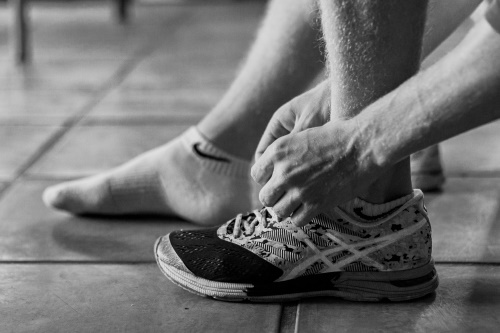Fitness isn’t just about fat loss and muscle gain; it’s also about movement, mobility, and flexibility. For example, when your ankle movement is limited, the rest of your movements can be limited if not thrown off-kilter. This can cause a cascade of avoidable issues that can easily be prevented with a few calculated exercises to improve ankle mobility.
What Is Ankle Mobility?
BREAKING: 1 Cup of This Melts Belly and Arm Fat (Take Before Bed)
How do you know if you have good ankle mobility?
Ankle mobility is the ability to move your ankle through a full range of motion without pain or restriction. It’s important to keep the muscles and tendons surrounding the ankle supple and limber. This flexibility allows you to freely move your ankle and, in turn, properly move other joints in the body.
There are several types of movement your ankles perform on the regular, including:
- Plantar flexion—when you point your foot at the ankle joint away from the body.
- Dorsiflexion—when you point your foot at the ankle joint toward the body.
- Inversion and eversion—these movements produce a side-to-side motion.
- Rotation—moving your foot around in either a clockwise or counterclockwise motion.
All of these movements can be part of an ankle mobility program.
How Do You Know If You Have Poor Ankle Mobility?
You may think you’re in decent shape and pretty flexible. But, if your heels come off the ground when you squat, you just might have poor ankle mobility. There are a few other tests you can do to assess your mobility.
For instance, try the knee-to-wall test. Stand in front of a wall with the toes of your right foot facing the wall with your toes against the wall or a couple of inches away. Place your other foot about half a step back. Lunge forward to try to touch your knee to the wall without lifting your heel, while keeping the hips even and facing forward. Move your foot back until the knee can just touch the wall while maintaining full foot contact with the floor. Once your heel lifts off the ground, that’s your sticking point.
What Causes Poor Ankle Mobility?
Poor ankle mobility can come from a number of causes. Just plain old inflexibility is often the culprit. Our bodies tend to stiffen with age, and you have to make a concerted effort to remain limber.
Another cause of poor ankle mobility can be injury or biomechanical dysfunction. If your movement is inhibited due to physical limitations, your joints may not be able to easily move through their full range of motion.
Similarly, diseases like arthritis can cause painful limitations when it comes to movement and mobility. This type of pain and restriction can lead to the development of alternate movement patterns, which ultimately put undue stress on the joints and ligaments.
Why Is Ankle Mobility Important?
Why is ankle mobility such a big deal? Because everything is connected and plays off each other. If your ankles are stiff, you set the rest of your body up for pain and injury.
Movement patterns develop from a lack of motion in the ankle joint. It can work havoc all the way up your body. For example, if your ankle won’t bend fully, it can cause your knee to overcompensate for the lack of movement. The next thing you know, your hip is out of alignment, and now your lower back or knees hurt.
Speed and agility are also affected by poor ankle mobility. You need to be able to twist, turn, jump, run, and squat without hesitation or limitation if you want to excel in your sport. Ankle mobility is the cornerstone of this power.
How to Improve Your Ankle Mobility
Improving ankle mobility should be on everybody’s workout checklist. Practice taking your ankles through their full range of motion. Here are a few great exercises and stretches you can do to help:
Bridge Foam Rolling—sit back on your hips and place the bridge of your right foot on a foam roller (no shoes!). With the load on your midfoot, lift your hips off the ground to bring yourself into a bridge position. Work through each toe, putting the pressure on them for a moment, one at a time. Return to the start and repeat on the opposite side.
Standing Heel Raises with Heel Drop—start with your toes on an elevated surface with your heels hanging off. Flex at the ankle to get up on your toes while raising your heels. Add weight over time to make this exercise more difficult. You can also drop your heels past the starting position when you bring them down to get a good stretch through your Achilles tendon. Repeat in sets of ten.
Plantar Foot Release—if this area is tight, it can restrict movement in the ankle. Get a small spiked therapy ball and roll the arch of your foot, applying gentle pressure.
Myofascial Calf Release—tight calves can also hinder ankle movement. Using a stick or even a foam roller, roll over your calf muscles with gentle pressure to release and stretch your tight calf muscles.
Knees Over Toes—start on a medium-height block, stepping up onto it with your right foot. Bend at the knee as far as you can go, bringing your knee past your toes until your heel starts to lift. Back up until your heel can stay in place, and then hold for a few seconds. Return to upright and repeat five times. Do both legs and then move down to a lower block. Practice this exercise daily until you are able to do it on the floor without your heel lifting off the ground.
Tip-Toe and Heel Walks—this fun exercise is simple. Walk forward for 20 steps only on your toes. Walk back to the start for 20 steps only on your heels. Repeat.
Banded Ankle Flexion and Dorsiflexion—while seated, loop a band around your foot, just below the toes, and provide tension while you point your foot forward. Do ten reps for each foot. Next, secure the band so the loop wraps around the top of your foot and scoot back so there is tension as you bend your foot up and back toward your body. Repeat ten times for each side.
TRENDING: Newly Legalized Herb Relieves Pain - Available Without A Prescription
Backward walking (or retro or reverse walking): Choose a safe location that’s clear, flat, and free of obstacles, such as a hallway, clear sidewalk, or field. You may also want to have someone spot you when you first begin to help prevent falls. After warming up with some ankle circles and walking forward for a few minutes, stand up straight with your feet hip-width apart. Relax your shoulders with your arms at your sides. Then begin walking backward, stepping toe to heel with each foot. Keep your steps short and controlled, with your back straight, gaze forward, and core tight. Go slowly and start with short sessions, working up to a ten-minute retro walk two to three times per week.
Don’t skimp on your ankle mobility exercises. They’re easy to do (and even fun) and take minimal time. Yet they go a long way toward keeping your body aligned and you, injury free. As a bonus, in time, you may even find your improved ankle mobility helps prevent knee and low-back pain.









